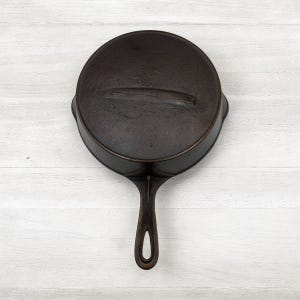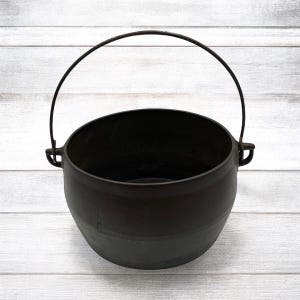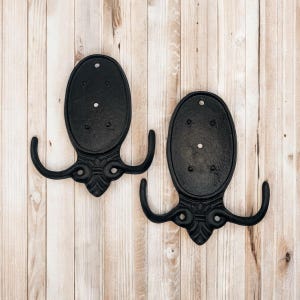








Griswold #4 702 A (NICKEL PLATED)
-
DetailsGriswold #4 702 A (NICKEL PLATED)
Ok so I admit that I was a little puzzled by this skillet at first. I'd never seen a silver Griswold before. It turns out these are pretty cool and rare. Castironcollector.com has great information on the history of "Plated Finish Ware." You can read that below but first I'd like to say this skillet is great condition for its age. No wobble or cracks. Only some minor pitting. The nickel plating is worn down to the cast iron in the middle and some plating has worn off from the bottom. (See pictures) All of this is completely normal for a plated skillet (Read Below.)
_________________________________________________________________________________________________________________________
Manufacturers early on realized there was a segment of the market that desired the features of cast iron cookware, but perhaps did not care for its rustic appearance or the maintenance it required. One of the first ways makers addressed this issue was to offer plated versions, first in a nickel finish, and later in chromium. Nickel-plated pieces are known from as early as the 1890s, with manufacturers seen moving to chromium in the 1930s.
Plated pieces varied in finish from a dull, silvery gray to a low luster to a bright mirror polish.
Griswold's "Silverlike" was a matte, unpolished chrome finish. Wagner's "Silverlite" appears to have been the same.
Griswold's "Du Chro", said to mean "dull chrome", was a combination, the bottoms and insides being satin, the sides, tops of handles, and other highlights being highly polished. This finish may have been a bit of marketing spin on leaving unpolished those parts that would be impossible or far too labor-intensive to polish or would otherwise soon become marred by usage anyway.
Du Chro appears to have meant different things at different times and on different Griswold pieces. In some cases the "dull" aspect is a bright satin finish; in others, a flat, matte grey coating. Some skillets many consider to be simply chrome have been seen labeled "Du Chro Ware".
Although pieces were plated inside and out, many of those seen give the impression of having been made leaving the cooking surface bare iron. It appears, however, that typical wear was simply consistent enough to make that inference. If true, the application of a substance would have been necessary to prevent the plating adhering to selected areas, but it would have required something that could withstand the high temperatures and acidic environment of the plating process. NOS (new old stock) pans with labels as well as catalog verbiage ("nickel plated finishes inside and out") confirm cookware plating was an all-over process.
Plating was popular enough that even cast iron cookware toys were seen plated.
Far fewer plated pieces are seen after the early 1940s, the decline perhaps WWII-related.
As collectibles, plated pieces appear to have value exceeding their bare iron counterparts only if the plating is completely intact. Otherwise, collectors seem to prefer and value bare iron over and above even minimally worn plating.
The question often arises regarding the removal of plating from worn pieces in order to leave them bare iron. While nickeled pieces appear simply to be plated versions of their plain iron counterparts, chromed pieces, where a mirror finish was desired, were first machine-polished smooth. De-plated chromed pieces will therefore not be the same as the versions originally produced as bare iron.
Similarly, the question is often asked about the possibility of re-plating worn pieces. The answer is that it would in most cases be too cost-prohibitive, and the result, being inauthentic, would not be considered as valuable as an intact original.
Is it nickel or is it chrome? Older pieces, especially those produced before the 1930s, are more likely to be nickel than chrome. Wagner used only nickel. Griswold plated its earlier pieces in nickel, but switched to chrome at about the beginning of the "large block" TM era. Nickel-plated pieces usually exhibit a warmer, yellowish tone whereas chrome (chromium) gives a colder, bluish impression. Nickel is often finished only to a soft luster; chrome typically to a high, mirror-like polish, if not left satin/matte.
Plated pieces can safely be cleaned using lye, and even very fine steel wool. Self-cleaning oven treatment may permanently discolor plating. Electrolysis cleaning should be used with caution, as it could remove plating, especially if its adhesion is already compromised.
LINK: https://www.castironcollector.com/plated.php -
Shipping & Policies
Shipping from United States
Processing time
1-2 business days
Estimated shipping times
- North America : 1 - 3 business days
I'll do my best to meet these shipping estimates, but can't guarantee them. Actual delivery time will depend on the shipping method you choose.
Customs and import taxes
Buyers are responsible for any customs and import taxes that may apply. I'm not responsible for delays due to customs.
Payment Options
Returns & Exchanges
I gladly accept returns and exchanges
Just contact me within: 3 days of delivery
Ship items back to me within: 7 days of delivery
I don't accept cancellations
But please contact me if you have any problems with your order.
The following items can't be returned or exchanged
Because of the nature of these items, unless they arrive damaged or defective, I can't accept returns for:
- Custom or personalized orders
- Perishable products (like food or flowers)
- Digital downloads
- Intimate items (for health/hygiene reasons)
Conditions of return
Buyers are responsible for return shipping costs. If the item is not returned in its original condition, the buyer is responsible for any loss in value.
Frequently Asked Questions
Gift wrapping and packaging
We will gladly Gift Wrap your item at no charge. Be sure to add your preference as a message from Buyer when ordering. Or, send us a separate convo.
How do you handle refunds for items received damaged?
All of our domestic shipments are insured. Just send us photos of the damaged item(s) and packaging within 3 days of receipt and we will issue an immediate refund, including original shipping charges. International Buyers will need to seek refunds from the shipping carrier; Bleak House 302 will be happy to provide you with purchase receipts, if needed.
What if I'm unhappy with the item once received?
We strive to do our best to accurately represent every item by photos and written description. We do not want unhappy customers! :( You may return any undamaged item within 7 days of receipt for a full credit of the sale price. Returned item shipping charges between Bleak House 302 and you and you and Bleak House 302 are not refundable.




